MIRASOUND Recording Studios New York, NY
Message Board - MIRASOUND Studios
|
AMPEX Corporation on Mira Sound Studios, NY:
In 1967, Mirasound recently moved to its new enlarged quarters on 57th Street. Five studios, four for audio, one for video, made up the complex. Always considered a leader at innovation, it was the first studio to put in 16-channel recording with the new Ampex two-inch multichannel recorders. Since receiving the recorder, it operated 10 to 12 hours each day. |
|
According to Robert Goldman, President of Mirasound, "When recording today's modern sounds, the Ampex 16-track recorder produces higher quality recordings. We find the new Ampex machine provides the maximum recording versatility and economy." In 1968 Mirasound will increase its multichannel capability even further with the delivery of two new MM-1000 multichannel recorders, one a 16 channel version, the other a 24 channel. "The new Ampex Master-Maker will offer us even more opportunity for creativity," Goldman said. The AG-1000 is a custom version of the new MM-1000 series, built especially for Mirasound. Both use Ampex videotape transports for two-inch tape, combined with electronics from Ampex's top-of-the-line AG-440 recorder. "With our 16-track recorder," Goldman said, "individual instrument sounds can be recorded on separate tracks, separately equalized, deleted or combined with other sounds on the tape at a later mix-down session." Having many tracks available means that a sound of doubtful quality can be temporarily saved and evaluated later. For example, a drum take can be compared with later takes with only the best one being saved for master recording. "With 8-track recording, tracks sometimes had to be cleared for this type of sound saving," Goldman continued. "Tracks one and two might have had to be combined and recorded on track three so that the second drum take could be recorded on track one. In doing this, track three became second generation, possibly of lesser quality than the original tracks. Tracks often had to be dubbed any number of times with the resultant music diminished in quality from the original." The final master tapes at Mirasound are mixed to two-track stereo for album release and single channel mono for singles on AG-350 recorders. Some of the groups that recorded regularly at Mirasound are The Lovin' Spoonful, The Happenings, Vanilla Fudge, The Doors, The Charrells (the first group to use 16-channel recording), Frankie Valli, The Bob Crewe Generation, and folk singer Janice lan. The Bob Crewe Generation did the "Girl Watchers Theme" at Mirasound, originally as a Pepsi Cola commercial. It was later released as a successful popular record. At a recent session, the rhythm section of the Lovin' Spoonful group was being recorded on the 16-channel Ampex recorder. This included a bass guitar, a piano and an autoharp on tracks two, three and four. Channel eight recorded a composite of the three other channels. Later in the evening the lead guitar and drums were added on tracks one and five. Just before the session broke up at midnight a second drum was added on track nine for more rhythm. On the following day a vocalist (and possibly a back up vocalist) were to come in to record the vocal part. Then Joe Wissert, the producer on these sessions for Kama Sutra, and the band got together to decide whether any other musicians should be added. Possibly a second lead guitar, another piano, or some brass, for a total of as many as seventeen or eighteen instruments might make up the final recording. This session was for one of a group of songs which eventually will come out in an album. The recording was done at 15 in/sec. In total, some 40 to 50 hours will be spent to record the dozen or so selections for the album. Flexibility with 16-track recording means that the best of the session can be mixed later to achieve the desired end product. Frequently, these groups haven't decided exactly the sound they are looking for on a particular song. Multitrack recording has benefitted them greatly because with a good sound mixer and control board the song can be re-assembled without interference between channels after the recording is done. Mirasound's board has four output busses and inputs for about a dozen microphones. The microphones include Electrovoice and Neumann condenser types used extremely close to the instrument for maximum isolation between channels. Each member of the recording group wears earphones to hear a composite signal of all instruments so they can get the total effect. |
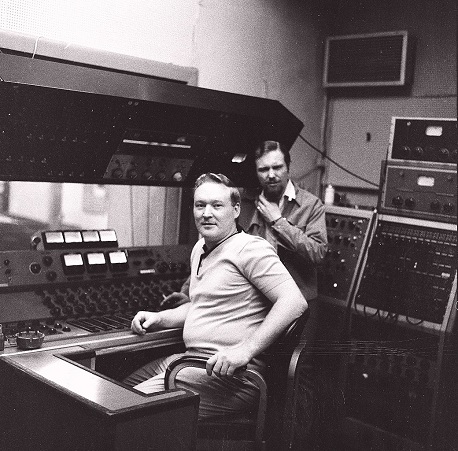
- MIRASOUND Engineers - George Schowerer and Skip Juried - Photo courtsey of George Schowerer.
|
In George Schowerer's words:
“The older hits were never made with anything but mono in mind. First of all, the smaller studios did not have multiple multitrack machines. Stea Phillips began with two stereo machines in their hotel studios. Mirasound initially had only two stereo machines for recording. They later added a 300 mono, and a three track ½” Ampex 300 with sel-sync. Even when we got an eight track Ampex AG-300-8, does anyone today have any idea how many tracks Bob Crewe needed on his sessions ?? Even with eight tracks, Bob used more channels than the orchestra. When the genius engineers who would do the mastering tried to make stereo out of the final eight tracks, they were limited in what it could sound like. |
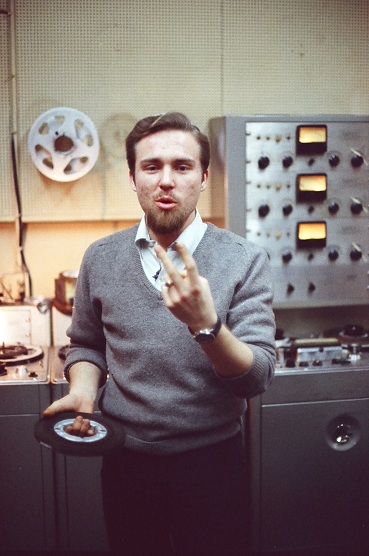
- Skip Juried - MIRASOUND Engineer - Photo courtesy of George Schowerer.
|
So, that’s where we get the orchestra on one track and the vocals on the other....because the orchestra was never given enough tracks to be able to spread in the mix. In fact, in those days, no one ever thought about stereo. Mirasound had a twelve input console with four buses. When we got the eight track recorder, I would use eight inputs to monitor the mix and use the last four to input all the overdubs...and I do mean ALL the overdubs! |
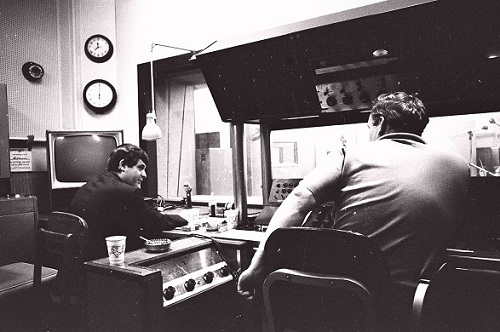
- George Schowerer in the Old Control Room at MIRASOUND Studios New York, NY - Photo Courtesy of George Schowerer.
|
The idea was to leave one or two tracks open for vocal takes. On top of those problems, the sync response on the AG-300-8 recorder was terrible. It was so poor, that I would bounce each group of tracks using the normal playback preamps in order to retain the original quality. (this method placed the new mix track out of sync with the other channels...so eventually, I had to bounce each additional track using the same method, until I had those six tracks in sync.
The last one or two tracks used for vocal were monitored using the sel-sync, since Frankie’s track never needed to be bounced. That’s why the quality on Beggin, My Mother’s Eyes, Can’t Take My Eyes Off You, Marianne, and all that group of songs sound as good as they do, so long as Rhino didn’t ‘bum them up’. However Crewe always went to Bell Sound for mastering to disc, and Bob would often add Bell’s live chamber to what I had used via the stereo EMT at Mira. |
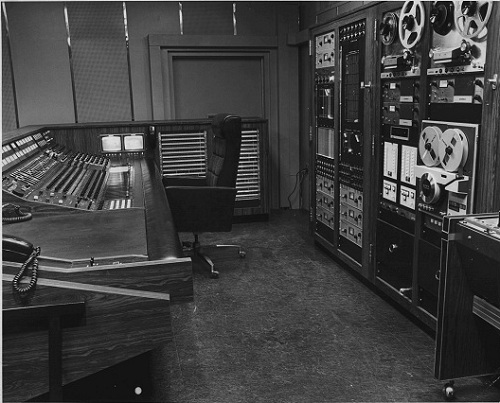
- New Control Room at MIRASOUND Studios New York, NY circa. 1969 - Photo Courtesy of George Schowerer.
|
This often caused the different amounts or type of echo to be so obvious. He would drive me crazy because I didn’t like Bell’s chamber...it’s bad enough that I can tell a record made at Bell because of the room leakage and the sound of their echo...I didn’t want that for mixes I made at Mira. I do believe we had a better sound at Mira. I used a modified RCA limiter which had the Columbia records mods, and at times used low frequency cut-offs to shape what leakage was inevitable at Mira.
The problem in those days was simply that you had to have a good picture in your mind as to what the final mix would sound like. In the mono to mono overdubbing during the early days of mixing, it was imperative that you had a clear understanding of what the final product would sound like...you couldn’t always go back to correct the mix. So when Bob came up with all the overdubs (sometimes using three horns, - three or four times - you had to understand what was being asked for and make sure it sounded like a single group at one sitting. |
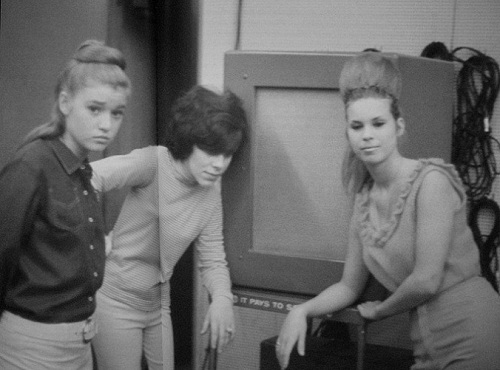
The Shangri-Las recording at MIRASOUND Studios, NY. Photo courtesy of unknown photographer.
|
The musicians often came back in an hour later, in order to avoid the union rep who might show up during the session (since overdubbing wasn’t in the union’s vocabulary). So now , when people are looking for the original multi-tracks in order to make stereo, they don't understand that the very thing they are looking for may not exist in the form they think-of as multi-track.... and if it did, it wouldn't be in matched pairs of tracks. Crewe even challenged sixteen tracks with all the ‘chachkas’ he would add. In many cases, I mixed live stereo two tracks during the session...most however, were quick mix-downs upon playback to the orchestra. |
Below is extraordinary photography of MIRASOUND Studios New York, NY with a fine array of AMPEX Recording Equipment. Unknown talent in the control room. Photos courtesy of Chris and Phyllis Juried. Text courtesy of George Schowerer.
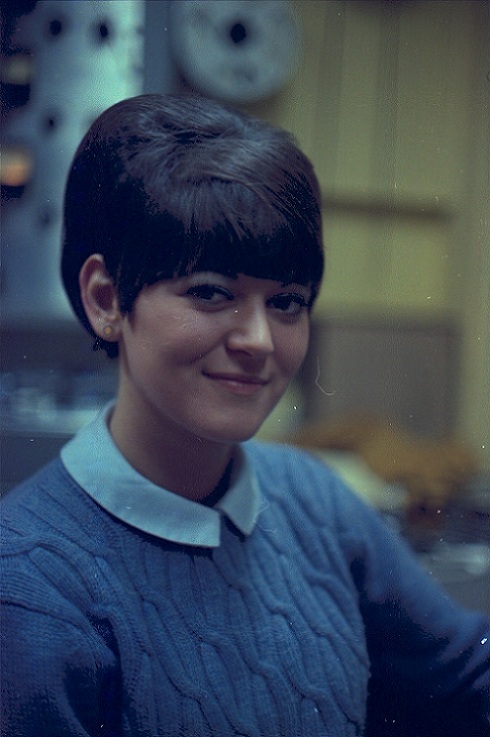
| You can be certain that Crewe never thought of releasing in stereo on the early stuff at all. It wasn't until he rushed in one day to do ‘Girl Watchers’ as a cover record that he asked me for stereo because it was a live large orchestra session with very few overdubs. "What Now My Love" with Mitch Ryder was done for stereo during that time period. Don't forget that only the large studios like RCA and Columbia had deep pockets for multi-track machines...and even then, Columbia’s first eight track recorder was built with four model 354 electronics and a 300 deck...see my photos of that machine on my photo disc. Smaller studios couldn't afford the cost. |
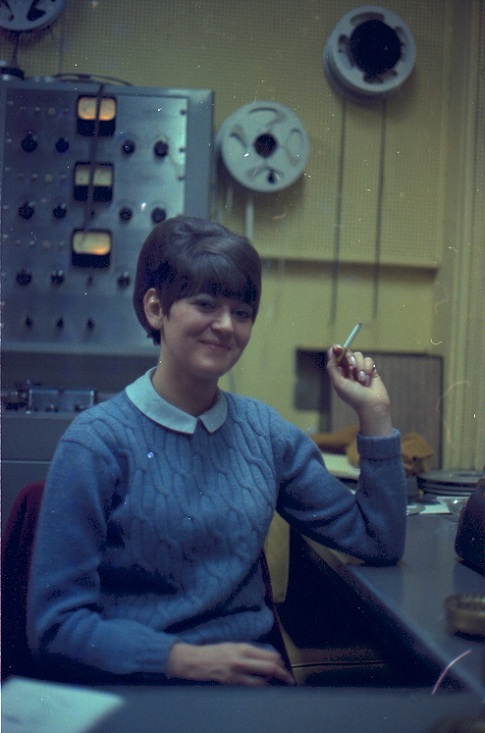
| We got the first sixteen track recorder at Mirasound only because we were going to use a 2" video deck with AG-350 electronics which we already owned. We then asked Ampex to make us 16 track heads for it. They came back, saying that since it was going to have the ‘name’ Ampex on it...they wanted to build it and lease it to us. They gave us a good deal and we could then afford to purchase it without all of our own work in building it. The rest is history. The day we received the unit at 10 am., I did the very first 16 track session of "With This Ring" by the Platters at 7pm with Luther Dixon producing. Amongst the other first 16 track recordings was ‘I’ve Got You Under My Skin’ with the Four Seasons" |
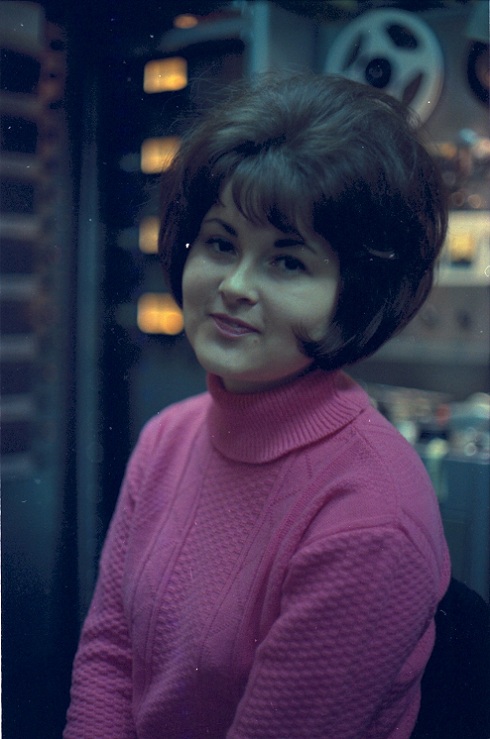

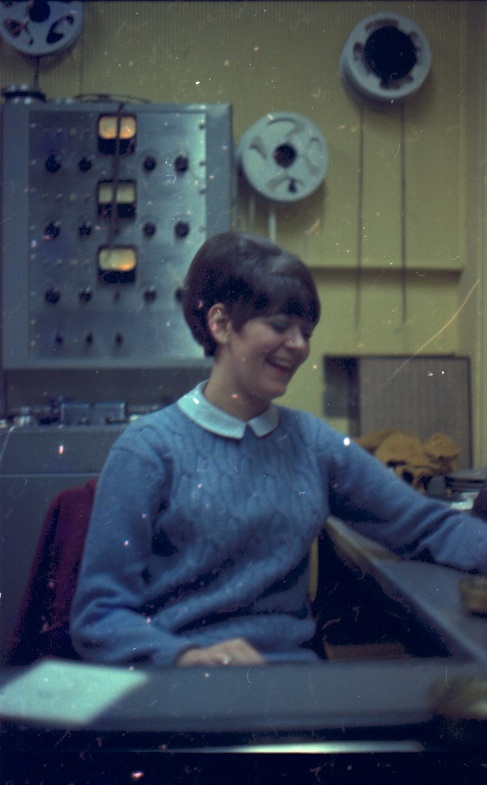
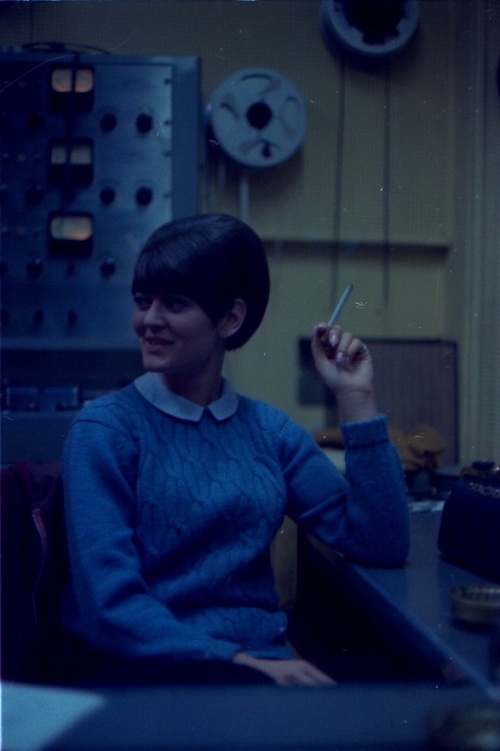
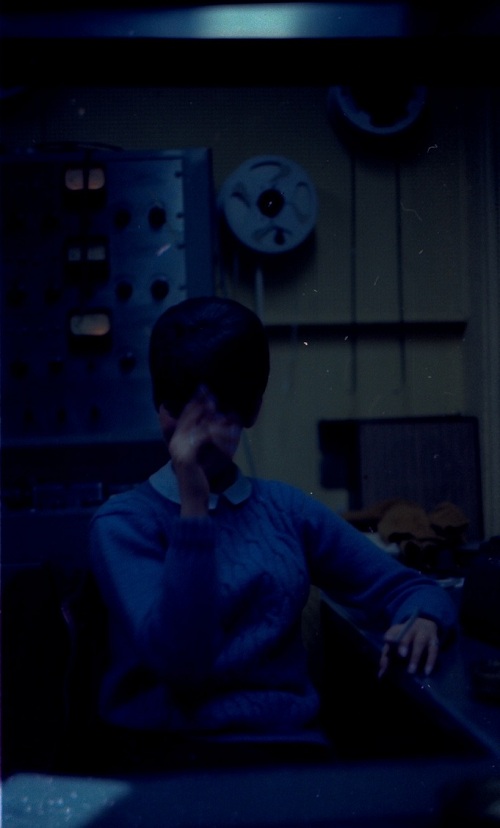
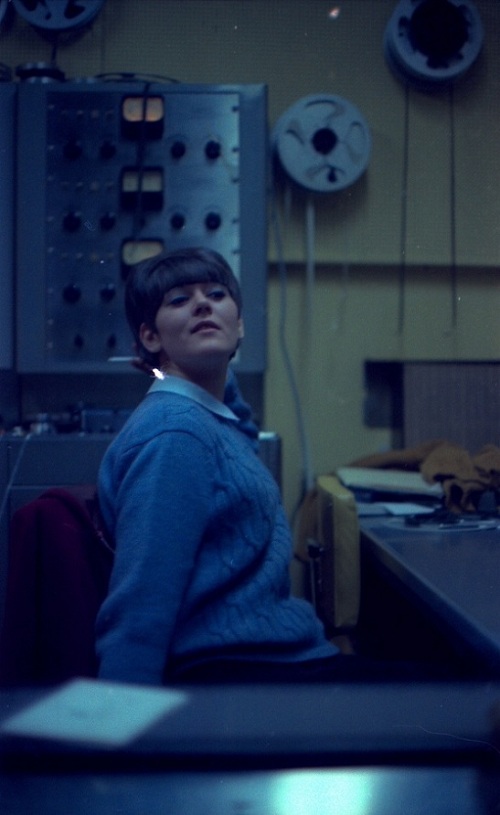
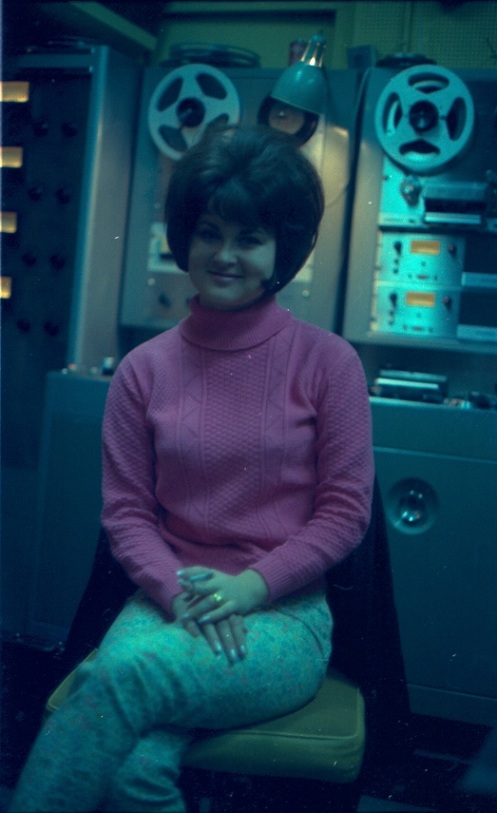
Do you have a great story about Mira Sound Studios New York, NY
Do you have a great story, to add, about Mira Sound Studios New York, NY or associated topics? Please feel free to Share it, here!
What other Visitors have said about Mira Sound Studios New York, NY
Click below to see contributions from other visitors to this page...
Bob and Lynn Goldman 




I think Bob and Lynn Goldman, and Mirasound Studio should be added. Many of the photos of individuals from the 50's and 60's were taken at Mirasound.
…
Jim reiter-Topwrench1948@yahoo.com 




I was 19 years old, in 1967. You have a pick of George Showerer and me in the old control room. I'm the fat guy on the right. Wasn't there long. Got drafted …
Nephew 




Bob was my uncle. I miss him and Lynn, his wife, a great deal. I grew up in Mirasound.
Scott Hornstein
First Studio for me: 15 yrs old. 




Bob Goldman was one of the most influential people in my audio career; set the stage for critical thinking, engineering, and hybridization of technologies. …
Me at the new board.. 




This is a shot of me at the new Big board in studio A. I believe this was a string section overdub of a Diana Ross session.
Bill Radice
Bill Radice Mirasound Engineer 1969-1973 




I worked there during a tumultuous period, although everything about Bob was a firestorm of ideas, plans, and construction, and endless construction. Bob …
Mira Sound Studios Photos Restoration 




Hi,
I was a big fan of Mira Sound Studios during the sixties where all the classic Shadow Morton productions took place. I was fascinated by some of …
Mira Sound Studios Ampex AG-1000 16 Track Not rated yet
The original Mira Sound Ampex AG-1000 16 track recorder was in a private studio on Long Island for years. And the studio also had the original MCI split …
The Golden Years of Rock n' Roll happened here. Not rated yet
I worked at Mirasound in the early 70's. I recall Stevie Wonder and Paul Simon coming in to record, and bumping into Nipsey Russell in the elevator quite …
Trying to figure out a record that's labeled Mirasound. Not rated yet
I have the song "He won't stay" and i was wondering if anyone knows whos the artist? It's a lady singer. Can you send me any artist you think it is? Thank …
Eric Siegel Not rated yet
I met Bob Goldman while I was working as a video technician at a closed circuit television company in New York City. He invited me to his studio and showed …
Mirasound Studio's - The Netherlands Not rated yet
Worked for them for many years, they are still in business after 60 yrs :-)
https://www.mirasound.nl/studio/
(Retired) Not rated yet
I remember a sound engineer named Bill McMeekin who worked at MiraSound around 1965. He and other MiraSound people often ate at Gus & Andy's Bar & Restaurant, …
"He Wont Stay" Not rated yet
Hi, this has to be a long shot but I used to own a 7" 45rpm acetate with your label on and in type it says "He Wont Stay" (being the song title, its a …
Return from Mirasound Studios New York, NY to Recording Studios and their History
Return from Mirasound Studios New York, NY to History of Recording - Homepage |


